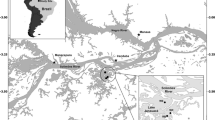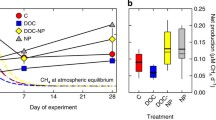Abstract
The simple biochemistry of H2 is critical to a large number of microbial processes, affecting the interaction of organisms with each other and with the environment. The sensitivity of each of these processes to H2 can be described collectively, through the quantitative language of thermodynamics. A necessary prerequisite is to understand the factors that, in turn, control H2 partial pressures. These factors are assessed for two distinctly different ecosystems. In anoxic sediments from Cape Lookout Bight (North Carolina, USA), H2 partial pressures are strictly maintained at low, steady-state levels by H2-consuming organisms, in a fashion that can be quantitatively predicted by simple thermodynamic calculations. In phototrophic microbial mats from Baja California (Mexico), H2 partial pressures are controlled by the activity of light-sensitive H2-producing organisms, and consequently fluctuate over orders of magnitude on a daily basis. The differences in H2 cycling can subsequently impact any of the H2-sensitive microbial processes in these systems. In one example, methanogenesis in Cape Lookout Bight sediments is completely suppressed through the efficient consumption of H2 by sulfate-reducing bacteria; in contrast, elevated levels of H2 prevail in the producer-controlled phototrophic system, and methanogenesis occurs readily in the presence of 40 mM sulfate.
Similar content being viewed by others
References
Alperin MJ, Blair NE, Albert DB, Hoehler TM & Martens CS (1992) Factors that control the carbon isotopic composition of methane produced in an anoxic marine sediment. Global Biogeochem. Cycles 6: 271–291.
Argano M & Schlegel HG (1992) The mesophilic hydrogen-oxidizing (knallgas) bacteria. In: Balows A, Trüper HG, Dworkin M, Harder W & Schleifer KH (Eds) The Prokaryotes (pp 344–384). Springer, New York.
Atkins PW (1990) Physical Chemistry. Oxford University Press, New York. Balashova VV & Zavarzin GA (1979) Anaerobic reduction of ferric iron by hydrogen bacteria. Microbiology (Engl. Trans. Mikrobiologiya) 48: 635-639.
Barker HA (1981) Amino acid degradation by anaerobic bacteria. Annu. Rev. Biochem. 50: 23–40.
Biagini GA, Finley BJ & Lloyd D (1997) Evolution of the hydrogenosome. FEMS Microbiol. Lett. 155(2): 133–140.
Boetius A, Ravenschlag K, Schubert CJ, Rickert D, Widdel F, Gieseke A, Amann R, Jørgensen BB, Witte U & Pfannkuche O (2000) A marine microbial consortium apparently mediating anaerobic oxidation of methane. Nature 407: 623–626.
Boone DR & Bryant MP (1980) Propionate-degrading bacterium, Syntrophobacter wolinii, sp. nov. gen. nov., from methanogenic ecosystems. Appl. Environ. Microbiol. 40: 626–632.
Bryant MP, Wolin EA, Wolin MJ & Wolfe RS (1967) Methanobacillus omelianskii, a syntrophic association of two species of bacteria. Arch. Microbiol. 59: 20–31.
Canfield DE & DesMarais DJ (1993) Biogeochemical cycles of carbon, sulfur, and free oxygen in a microbial mat. Geochim. Cosmochim. Acta 57: 3971–3984.
Canuel EA (1992) Seasonal Variations in the sources and accumulation of organic matter in a coastal sediment. Ph.D., University of North Carolina.
Chanton JP, Martens CS & Kipphut GW (1983) Lead-210 sediment geochronology in a changing coastal environment. Geochim. Cosmochim. Acta 47: 1791–1804.
Chen M & Wolin MJ (1977) Influence of CH4 production by Methanobacterium ruminantium on the fermentation of glucose and lactate by Selenomonas ruminantium. Appl. Environ. Microbiol. 34: 756–759.
Conrad R & Wetter B (1990) Influence of temperature on energetics of hydrogen metabolism in homoacetogenic, methanogenic, and other anaerobic bacteria. Arch. Microbiol. 155: 94–98.
Conrad R, Schink B & Phelps TJ (1986) Thermodynamics of H2-consuming and H2-producing metabolic reactions in diverse methanogenic environments under in situ conditions. FEMS Microbiol. Ecol. 38: 353–360.
Conrad R, Lupton FS & Zeikus JG (1987) Hydrogen metabolism and sulfate-dependent inhibition of methanogenesis in a eutrophic lake sediment (Lake Mendota). FEMS Microbiol. Ecol. 45: 107–115.
Cord-Ruwisch R, Seitz H-J & Conrad R (1988) The capacity of hydrogenotrophic anaerobic bacteria to compete for traces of hydrogen depends on the redox potential of the terminal electron acceptor. Arch. Microbiol. 149: 350–357.
Crill PM & Martens CS (1987) Biogeochemical cycling in an organic-rich coastal marine basin, 6. Temporal and spatial variations in sulfate reduction rates. Geochim. Cosmochim. Acta 51: 1175–1186.
DesMarais DJ (1995) The biogeochemistry of hypersaline microbial mats. In: Jones JG (Ed) Advances in Microbial Ecology, Vol. 14. Plenum, New York.
Dolfing J (1988) Acetogenesis. In: Zehnder AJB (Ed) Biology of Anaerobic Microorganisms (pp 417–468). Wiley-Interscience, New York.
Ferry JG (1992) Biochemistry of methanogenesis. Crit. Rev. Biochem. Mol. Biol. 27: 473–503.
Ferry JG & Wolfe RS (1976) Anaerobic degradation of benzoate to methane by a microbial consortium. Arch. Microbiol. 107: 33–40.
Hinrichs K-U, Hayes JM, Sylva SP, Brewer PG & DeLong EF (1999) Methane-consuming archaebacteria in marine sediments. Nature 398: 802–805.
Hoehler TM, Alperin MJ, Albert DB & Martens CS (1994) Field and laboratory studies of methane oxidation in an anoxic marine sediment: evidence for a methanogen-sulfate reducer consortium. Global Biogeochem. Cycles 8(4): 451–463.
Hoehler TM, Alperin MJ, Albert DB & Martens CS (1998) Thermodynamic control on H2 concentrations in an anoxic marine sediment. Geochim. Cosmochim. Acta 62: 1745–1756.
Hoehler TM, Alperin MJ, Albert DB & Martens CS (2001a) Apparent minimum free energy requirements for methanogenic archaea and sulfate-reducing bacteria in an anoxic marine sediment. FEMS Microbiol. Ecol. 38: 33–41.
Hoehler TM, Bebout BM & DesMarais DJ (2001b) The role of microbial mats in the production of reduced gases on the early Earth. Nature 412: 324–327.
Houchins JP (1984) The physiology and biochemistry of hydrogen metabolism in cyanobacteria. Biochim. Biophys. Acta 768: 227–255.
Iannotti EL, Kafkewitz D, Wolin MJ & Bryant MP (1973) Glucose fermentation products of Ruminococcus albus grown in continuous culture with Vibrio succinogenes: Changes caused by interspecies transfer of H2. J. Bacteriol. 114: 1231–1240.
Klump JV & Martens CS (1989) The seasonality of nutrient regeneration in an organic-rich coastal sediment: kinetic modeling of changing pore-water nutrient and sulfate distributions. Limnol. Oceanogr. 34: 559–577.
Kondratieva EN, Pfennig N & Trüper HG (1992) The phototrophic Prokaryotes. In: Balows A, Trüper HG, Dworkin M, Harder W & Schleifer KH (Eds) The Prokaryotes (pp 312–330). Springer, New York.
Laanbroek HJ, Abee T & Voogd JL (1982) Alcohol conversions by Desulfobulbus propionicus Lindhorst in the presence and absence of sulfate and hydrogen. Arch.Microbiol. 133: 178–184.
Lee MJ & Zinder SH (1988) Isolation and characterization of a thermophilic bacterium which oxidizes acetate in syntrophic association with a methanogen and which grows acetogenically on H2-CO2. Appl. Environ. Microbiol. 54: 124–129.
Lovley DR & Goodwin S (1988) Hydrogen concentrations as an indicator of the terminal electron-accepting reactions in aquatic sediments. Geochim. Cosmochim. Acta 52: 2993–3003.
Lovley DR & Klug MJ (1983) Sulfate reducers can outcompete methanogens at freshwater sulfate concentrations. Appl. Environ. Microbiol. 45: 187–192.
Lovley DR, Dwyer DF & Klug MJ (1982) Kinetic analysis of competition between sulfate reducers and methanogens for hydrogen in sediments. Appl. Environ. Microbiol. 43: 1373–1379.
Lovley DR, Phillips EJP & Lonergan DJ (1989) Hydrogen and formate oxidation coupled to dissimilatory reduction of iron or manganese by Alteromonas putrefaciens. Appl. Environ. Microbiol. 55: 700–706.
Madigan MT, Martinko JM & Parker J (1996) Brock Biology of Microorganisms. Prentice Hall, Upper Saddle River, NJ. Marrink SJ & Berendsen HJC (1996) Permeation process of small mo585 lecules across lipid membranes studied by molecular dynamics simulations. J. Phys. Chem. 100: 16729-16738.
Martens CS & Berner RA (1974) Methane production in the interstitial waters of sulfate depleted marine sediments. Science 185: 1167–1169.
Martens CS & Klump JV (1984) Biogeochemical cycling in an organic rich coastal marine basin: 4. An organic carbon budget for sediments dominated by sulfate reduction and methanogenesis. Geochim. Cosmochim. Acta 48: 1987–2004.
Martens CS, Haddad RI & Chanton JP (1992) Organic matter accumulation, remineralization and burial in an anoxic coastal sediment. In: Whelan JK & Farrington JW (Eds) Productivity, Accumulation, and Preservation of Organic Matter: Recent and Ancient Sediments (pp 82–98). Columbia University Press, New York.
Martin W & Muller M (1998) The hydrogen hypothesis for the first eukaryote. Nature 392(6671): 37–41.
McInerney MJ, Bryant MP & Pfennig N (1979) Anaerobic bacterium that degrades fatty acids in syntrophic association with methanogens. Arch. Microbiol. 122: 129–135.
Mortenson LE (1978) The role of dihydrogen and hydrogenase in nitrogen fixation. Biochimie 60: 219–223.
Mountfort DO & Bryant MP (1982) Isolation and characterization of an anaerobic syntrophic benzoate-degrading bacterium from sewage sludge. Arch. Microbiol. 133: 249–256.
Orphan VJ, House CH, Hinrichs KU, McKeegan KD & DeLong EF (2001) Methane-consuming archaea revealed by directly coupled isotopic and phylogenetic analysis. Science 293: 484–487.
Pancost RD, Damsté JSS, Lint SD, Van der Maarel MJEC & Gottschal JC (2000) Biomarker evidence for widespread anaerobic methane oxidation in Mediterranean sediments by a consortium of methanogenic archaea and bacteria. Appl. Environ. Microbiol. 66(3): 1126–1132.
Phelps TJ, Conrad R & Zeikus JG (1985) Sulfate-dependent interspecies H2 transfer between Methanosarcina barkeri and Desulfovibrio vulgaris during coculture metabolism of acetate or methanol. Appl. Environ. Microbiol. 50: 589–594.
Sansone FJ & Martens CS (1982) Volatile fatty acid cycling in organic-rich marine sediments. Geochim. Cosmochim. Acta 46: 1575–1589.
Scheifinger CC, Linehan B & Wolin MJ (1975) H2 production by Selenomonas ruminantium in the absence and presence of methanogenic bacteria. Appl. Microbiol. 29: 480–483.
Schink B (1988) Principles and limits of anaerobic degradation. In: Zehnder AJB (Ed) Biology of Anaerobic Microorganisms (pp 771–846). Wiley-Interscience, New York.
Schink B (1992) Syntrophism among Prokaryotes. In: Balows A, Trüper HG, Dworkin M, Harder W & Schleifer KH (Eds) The Prokaryotes (pp 276–299). Springer, New York.
Sharak-Genthner BR, Davis CL & Bryant MP (1981) Features of rumen and sewage sludge strains of Eubacterium limosum, a methanol-and H2-CO2-utilizing species. Appl. Environ. Microbiol. 42: 12–19.
Sørensen KB, Finster K & Ramsing NB (2001) Thermodynamic and kinetic requirements in anaerobic methane oxidizing consortia exclude hydrogen, acetate, and methanol as possible electron shuttles. Microb. Ecol. 42: 1–10.
Tewes FJ & Thauer RK (1980) Regulation of ATP-synthesis in glucose fermenting bacteria involved in interspecies hydrogen transfer. In: Gottschalk G, Pfennig N & Werner H (Eds) Anaerobes and Anaerobic Infections (pp 97–104). Gustav Fischer, Stuttgart.
Thamdrup B (2000) Bacterial manganese and iron reduction in aquatic sediments. In: Schink B (Ed) Advances in Microbial Ecology, Vol. 16 (pp 41–84). Kluwer Academic/Plenum, New York.
Tiedje JM (1988) Ecology of denitrification and assimilatory nitrate reduction to ammonium. In: Zehnder AJB (Ed) Biology of Anaerobic Microorganisms (pp 179–244). Wiley-Interscience, New York.
Valentine DL & Reeburgh WS (2000) New perspectives on anaerobic methane oxidation. Environ. Microbiol. 2(5): 477–484.
van Hoek AH, van Alen TA, Sprakel VS, Leunissen JA, Brigge T, D. VG & Hackstein JH (2000) Multiple acquisition of methanogenic archaeal symbionts by anaerobic ciliates. Mol. Biol. Evol. 17(2): 251–258.
Westermann P (1994) The effect of incubation temperature on steady-state concentration of hydrogen and volatile fatty acids during anaerobic degradation in slurries from wetland sediments. FEMS Microbiol. Ecol. 13: 295–302.
Widdel F (1988) Microbiology and ecology of sulfate-and sulfur-reducing bacteria. In: Zehnder AJB (Ed) Biology of Anaerobic Microorganisms (pp 469–586). Wiley-Interscience, New York.
Wolin MJ (1976) Interactions between H2-producing and methaneproducing species. In: Schlegel HG, Gottschalk G & Pfennig N (Eds) Microbial Formation and Utilization of Gases. E. Goltze KG, Göttingen.
Wolin MJ & Miller TL (1982) Interspecies hydrogen transfer: 15 years later. ASM News 48: 561–565.
Wolin MJ, Wolin EA & Jacobs NJ (1961) Cytochrome-producing anaerobic vibrio, Vibrio succinogenes, Sp. N. J. Bacteriol. 81: 911–917.
Wu W-M, Hickey RF, Jain MK & Zeikus JG (1993) Energetics and regulations of formate and hydrogen metabolism by Methanobacterium formicicum. Arch. Microbiol. 159: 57–65.
Zehnder AJB & Brock TD (1979) Methane formation and methane oxidation by methanogenic bacteria. J. Bacteriol. 137: 420–432.
Zehnder AJB & Brock TD (1980) Anaerobic methane oxidation: occurrence and ecology. Appl. Environ. Microbiol. 39: 194–204.
Zehnder AJB & Stumm W (1988) Geochemistry and biogeochemistry of anaerobic habitats. In: Zehnder AJB (Ed) Biology of Anaerobic Microorganisms (pp 1–38). Wiley-Interscience, New York.
Zinder SH (1993) Physiological Ecology of Methanogens. In: Ferry JG (Ed) Methanogenesis (pp 128–206). Chapman & Hall, New York.
Author information
Authors and Affiliations
Rights and permissions
About this article
Cite this article
Hoehler, T.M., Albert, D.B., Alperin, M.J. et al. Comparative ecology of H2 cycling in sedimentary and phototrophic ecosystems. Antonie Van Leeuwenhoek 81, 575–585 (2002). https://doi.org/10.1023/A:1020517924466
Issue Date:
DOI: https://doi.org/10.1023/A:1020517924466




